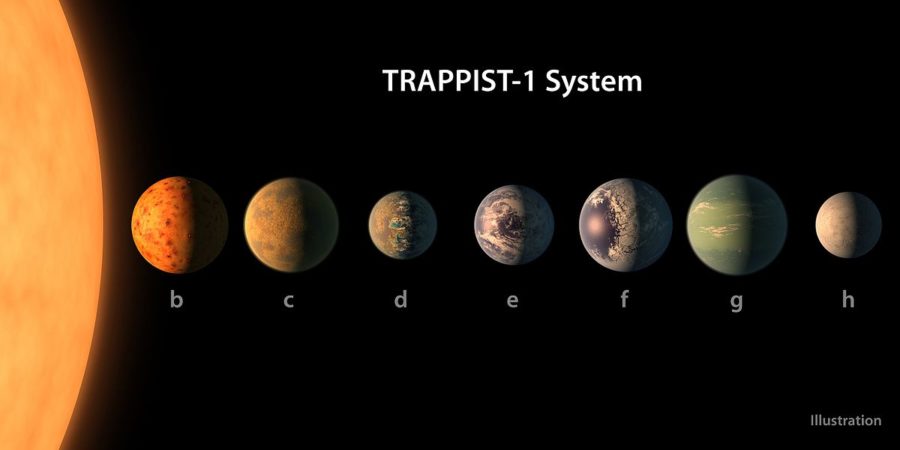NASA Discovers 7 Earth-Size Planets
Are we alone out here? Astronomers have recently found seven earth-sized planets orbiting around a star that could be our next step to finding another habitable planet. The exoplanets are orbiting around the dwarf star TRAPPIST-1, in the constellation Aquarius, about 40 light-years away, which is 235 trillion miles from Earth. This new discovery by NASA could be monumental for scientists. Three of the planets, known as TRAPPIST-1e, TRAPPIST-1f, and TRAPPIST-1g are theorized to be the most suitable for harboring life. NASA scientists are already showing hope for the new discovery and ones to come, “The discovery gives us a hint that finding a second Earth is not just a matter of if, but when,” said Thomas Zurbuchen, Associate and Administrator of the Science Mission Director at NASA headquarters.
The exoplanets were discovered by Michael Gillon, an Astronomer at the University of Liege, in Belgium and his team, using NASA’s Spitzer Space Telescope. By using the telescope, the team was able to determine the mass and size of the planets. They found the size of the planets to be similar to Earth’s size or slightly smaller. In addition, knowing the density of the planets helps them determine the composition of them, either being rocky, gaseous, or watery. Out of the seven planets, three are in a habitable zone also referred to as the “Goldilocks” zone. These zones could be temperate, where pools of liquid water could exist, “In fact, with the right atmospheric conditions, there could be water on any of these planets,” said Thomas Zurbuchen during a news briefing at NASA Headquarters in Washington on February 22, 2017. The Spitzer follows the Earth’s orbit and is an infrared telescope that is perfect for studying the TRAPPIST-1 stars bright infrared glow, helping astronomers discover its seven orbiting planets by continuously observing TRAPPIST-1 for a span of 500 hours in the fall of 2016. The telescope was studying the change in brightness from the star light, as its planets orbited it. The star, which is about a tenth of the sun’s weight and significantly cooler in temperature, is classified as an “ultra-cool dwarf.” Its temperatures could allow liquid water on planets orbiting very close to survive. In comparison to our solar system, the planetary orbits of TRAPPIST-1 are closer to it than Mercury is to the sun.
Using the Trappist, a telescope, (TRAnsiting Planets and Planetesimals Small Telescope) in La Silla, Chile, researchers were able to make initial observations and discoveries of the dim dwarf star. With this telescope, scientists studied the TRAPPIST-1 star and in May of 2016 found three planets orbiting around the star. With further research from a ground telescope, called the European Southern Observatory’s telescope, more compelling evidence was shown which then advanced the research to the Spitzer Space Telescope enabling astronomers to validate the existence of the three planets. Now in February of 2017, astronomers have confirmed the existence of not three but seven earth-like planets. “The seven wonders of TRAPPIST-1 are the first Earth-size planets that have been found orbiting this kind of star,” said lead researcher Michael Gillon.
The planets orbiting the dim dwarf star have orbits ranging from one and a half to 20 days. Surprisingly, the planets orientations are very close, allowing for astronomers to study the atmosphere and other aspects of the planets in great detail. Due to the closeness of these planets, if you are on one of them you would have an amazing view of the others. They would not look like the planets Venus and Mars that we can see in the night sky as little bright lights, they would appear bigger than the moon.
In 2018, NASA is planning to launch the James Webb Space Telescope, which will have more advanced technology which will, “…be able to detect the chemical fingerprint of water, methane oxygen, ozone, and other components of planet’s atmosphere,” as well as being a more sensitive telescope. A planet’s pressure and temperature will also be accounted for by the Webb, another vital aspect of a planet being habitable.
For more information on the recent discovery and the telescopes visit https://www.nasa.gov/press-release/nasa-telescope-reveals-largest-batch-of-earth-size-habitable-zone-planets-around

Hello! My name's Kate, I am currently a sophomore and I’ll be the Junior Photo Editor for the Jetstream Journal. I have lived in Colorado my whole life...














Bethany Diaz • Mar 2, 2017 at 12:19 pm
Wow! Great article. This is so cool! This discovery could lead to the finding of aliens, cool.